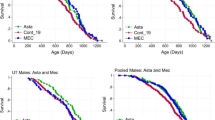Abstract
S-Adenosylmethionine (SAM) is an important metabolite that participates in many reactions as a methyl group donor in all organisms, and has attracted much interest in clinical research because of its potential to improve many diseases, such as depression, liver disease, and osteoarthritis. Because of these potential applications, a more efficient means is needed to produce SAM. Accordingly, we developed a positive selection method to isolate SAM-accumulating yeast in this study. In Saccharomyces cerevisiae, one of the main reactions consuming SAM is thought to be the methylation reaction in the biosynthesis of ergosterol that is catalyzed by Erg6p. Mutants with deficiencies in ergosterol biosynthesis may accumulate SAM as a result of the reduction of SAM consumption in ergosterol biosynthesis. We have applied this method to isolate SAM-accumulating yeasts with nystatin, which has been used to select mutants with deficiencies in ergosterol biosynthesis. SAM-accumulating mutants from S. cerevisiae K-9 and X2180-1A were efficiently isolated through this method. These mutants accumulated 1.7–5.5 times more SAM than their parental strains. NMR and GC-MS analyses suggested that two mutants from K-9 have a mutation in the erg4 gene, and erg4 disruptants from laboratory strains also accumulated more SAM than their parental strains. These results indicate that mutants having mutations in the genes for enzymes that act downstream of Erg6p in ergosterol biosynthesis are effective in accumulating SAM.






Similar content being viewed by others
References
Barton DHR, Corrie JET, Widdowson DA, Bard M, Woods RA (1974) Biosynthesis of terpenes and steroids. Part IX. The sterols of some mutant yeasts and their relationship to the biosynthesis of ergosterol. J Chem Soc, Perkin Trans I 148:1326–1333
Bradley JD, Flusser D, Katz BP, Schumacher HR Jr, Brandt KD, Chambers MA, Zonay LJ (1994) A randomized, double blind, placebo controlled trial of intravenous loading with S-adenosylmethionine (SAM) followed by oral SAM therapy in patients with knee osteoarthritis. J Rheumatol 21:905–911
Daum G, Lees ND, Bard M, Dickson R (1998) Biochemistry, cell biology and molecular biology of lipid of Saccharomyces cerevisiae. Yeast 14:1471–1510
Dickinson JR, Schweizer M (1999) The metabolism and molecular physiology of Saccharomyces cerevisiae. Taylor & Francis, London, pp 79–135
Inoue T, Iefuji H, Fujii T, Soga H, Satoh K (2000) Cloning and characterization of a gene complementing the mutation of an ethanol-sensitive mutant of sake yeast. Biosci Biotechnol Biochem 64:229–236
Kobayashi GS, Medoff G (1977) Antifungal agents: recent developments. Annu Rev Microbiol 31:291–308
Lieber CS (2002) S-Adenosyl-l-methionine: its role in the treatment of liver disorders. Am J Clin Nutr 76:1183S–1187S
Martínez-Chantar ML, Garcia-Trevijano ER, Latasa MU, Pérez-Mato I, Sánchez del Pino MM, Corrales FJ, Avila MA, Mato JM (2002) Importance of a deficiency in S-adenosyl- l-methionine synthesis in the pathogenesis of liver injury. Am J Clin Nutr 76:1177–1182
Mischoulon D, Fava M (2002) Role of S-adenosyl-l-methionine in the treatment of depression: a review of the evidence. Am J Clin Nutr 76:1158–1161
Molzahn SW, Woods RA (1972) Polyene resistance and the isolation of sterol mutants in Saccharomyces cerevisiae. J Gen Microbiol 72:339–348
Morrison LD, Smith DD, Kish SJ (1996) Brain S-adenosylmethionine levels are severely decreased in Alzheimer's disease. J Neurochem 67:1328–1331
Newman PE (2000) Alzheimer's disease revisited. Med Hypotheses 54:774–776
Nguyen M, Gregan A (2002) S-Adenosylmethionine and depression. Aust Fam Physician 31:339–343
Padova C (1987) S-Adenosylmethionine in the treatment of osteoarthritis. Review of the clinical studies. Am J Med 83:60–65
Pañak CK, Giorgieri SA, Díaz LE, Ruiz OA (1997) Simultaneous determination of S-adenosylmethionine and S-adenosylhomocystein by capillary zone electrophoresis. Electrophoresis 18:2047–2049
Parks LW (1958) S-Adenosylmethionine and ergosterol biosynthesis. J Am Chem Soc 80:2023–2024
Purohit V, Russo D (2002) Role of S-adenosyl-l-methionine in the treatment of alcoholic liver disease: introduction and summary of the symposium. Alcohol 27:151–154
Saletu B, Anderere P, Padova CD, Assandri A, Saletu-Zyhlarz GM (2002) Electrophysiological neuroimaging of the central effects of S-adenosyl-l-methionine by mapping of electroencephalograms and event-related potentials and low-resolution brain electromagnetic tomography. Am J Clin Nutr 76:1162–1171
Shiomi N, Fukuda H, Murata K, Kimura A (1995) Improvement of S-adenosylmethionine production by integration of the ethionine-resistance gene into chromosomes of the yeast Saccharomyces cerevisiae. Appl Microbiol Biotechnol 42:730–733
Shiozaki S, Shimizu S, Yamada H (1984) Unusual intracellular accumulation of S-adenosyl-l-methionine by microorganisms. Agric Biol Chem 48:2293–2300
Shiozaki S, Shimizu S, Yamada H (1989) S-Adenosyl-l-methionine production by Saccharomyces sake: optimization of the culture conditions for the production of cells with a high S-adenosyl-l-methionine content. Agric Biol Chem 53:3269–3274
Tabor CW, Tabor H (1984) Methionine adenosyltransferase (S-adenosylmethionine synthetase) and S-adenosylmethionine decarboxylase. Adv Enzymol 56:251–282
Taylor UF, Kisic A, Pascal RA, Izumi A, Tsuda M, Schoepfer GJ (1981) Sterol synthesis: a simple method for the isolation of zymosterol (5α-cholasta-8,24-dien-3β-ol) from yeast and spectral properties of zymosterol. J Lipid Res 22:171–177
Thomas D, Surdin-Kerjan Y (1997) Metabolism of sulfur amino acids in Saccharomyces cerevisiae. Microbiol Mol Biol Rev 61:503–532
Trocha PJ, Jasne SJ, Sprinson DB (1977) Yeast mutants blocked in removing the methyl group of lanosterol at C-14. Separation of sterols by high-pressure liquid chromatography. Biochemistry 16:4721–4726
Zweytick D, Hrastnik C, Kohlwein SD, Daum G (2000) Biochemical characterization and subcellular localization of the sterol C-24(28) reductase, Erg4p, from the yeast Saccharomyces cerevisiae. FEBS Lett 470:83–87
Author information
Authors and Affiliations
Corresponding author
Rights and permissions
About this article
Cite this article
Shobayashi, M., Mukai, N., Iwashita, K. et al. A new method for isolation of S-adenosylmethionine (SAM)-accumulating yeast. Appl Microbiol Biotechnol 69, 704–710 (2006). https://doi.org/10.1007/s00253-005-0009-7
Received:
Revised:
Accepted:
Published:
Issue Date:
DOI: https://doi.org/10.1007/s00253-005-0009-7




